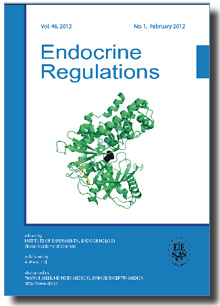Journal info
|
||
Select Journal
Journals
Bratislava Medical Journal Ekologia - Ecology Endocrine Regulations 2015 2014 2013 2012 2011 2010 2009 2008 2007 2006 2005 2004 2003 General Physiology and Biophysics Neoplasma Acta Virologica Studia Psychologica Cardiology Letters Psychológia a patopsych. dieťaťa Kovove Materialy-Metallic Materials Slovenská hudba 2025Webshop Cart
Your Cart is currently empty.
Info: Your browser does not accept cookies. To put products into your cart and purchase them you need to enable cookies.
Endocrine Regulations Vol.48, No.4, p.163-172, 2014 |
||
| Title: A wider view on gastric erosion: detailed evaluation of complex somatic and behavioral changes in rats treated with indomethacin at gastric ulcerogenic dose | ||
| Author: L. P. Filaretova, T. R. Bagaeva, O. Y. Morozova, D. Zelena | ||
| Abstract: Objective. Gastric erosion is widespread side effect of nonsteroidal anti-inflammatory drugs. To examine the complexity of the brain-gut axis regulation, indomethacin-induced gastric erosion formation was studied in connection with somatic and behavioral changes. Methods. During a constant telemetric recording of heart rate, body temperature, and locomotion of male rats we examined the effects of 24 h fasting, indomethacin (35 mg/kg s.c.) injection, and refeeding at 4 h. Behavior was analyzed on elevated plus maze (EPM) at 24 h and somatic changes at 72 h. Results. Gastric erosion developed 4 h after indomethacin injection, healed 72 h later contrasted by large injury in the small intestine. As classical signs of chronic stress, body and thymus weight were reduced while adrenal weight was enhanced 72 h after indomethacin injection. Fasting by itself changed all telemetrically recorded parameters with most prominent decrease in heart rate. Indomethacin induced similar diminishing effects with earliest and strongest temperature decrease. As a sign of more anxious phenotype locomotion reducing effect of indomethacin injection was detected on EPM. The EPM-induced temperature elevation was missing in indomethacin-treated animals. Conclusions. Fasting by itself induce somatic changes, which can make the animals more vulnerable to ulcerogenic stimuli. Development of indomethacin-induced gastrointestinal lesions happened in parallel with disturbances of heart rate, core body temperature, and chronic stress-like somatic changes as well as anxiety-like behavior. We have to be more aware of the existence of the brain-gut axis and should study changes in the whole body rather than focusing on a specific organ. |
||
| Keywords: indomethacin, gastrointestinal injury, telemetry, heart rate, body temperature, locomotion, somatic parameters, elevated plus maze. | ||
| Year: 2014, Volume: 48, Issue: 4 | Page From: 163, Page To: 172 | |
| doi:10.4149/endo_2014_04_163 |
||
|
Price:
20.00 €
|
||
|
|
||

